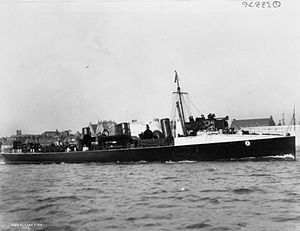HMS Flying Fish (1897)

HMS Flying Fish
|
|
| History | |
|---|---|
|
|
|
| Name: | HMS Flying Fish |
| Ordered: | 1895 – 1896 Naval Estimates |
| Builder: | Palmers Shipbuilding and Iron Company Jarrow-on-Tyne |
| Laid down: | 9 August 1896 |
| Launched: | 4 March 1897 |
| Commissioned: | June 1898 |
| Out of service: | Laid up in reserve, 1919 |
| Fate: | Sold for breaking, 30 August 1919 |
| General characteristics | |
| Class and type: | Palmer three funnel, 30 knot destroyer |
| Displacement: |
|
| Length: | 219 ft 9 in (66.98 m) o/a |
| Beam: | 20 ft 9 in (6.32 m) |
| Draught: | 8 ft 11 in (2.72 m) |
| Installed power: | 6,000 shp (4,500 kW) |
| Propulsion: |
|
| Speed: | 30 kn (56 km/h) |
| Range: |
|
| Complement: | 60 officers and men |
| Armament: |
|
| Service record | |
| Operations: | World War I 1914 - 1918 |
HMS Flying Fish was a Palmer three funnel, 30 knot destroyer ordered by the Royal Navy under the 1896 – 1897 Naval Estimates. She was the tenth ship to carry this name.
Flying Fish was laid down on 9 August 1896 at the Palmer shipyard at Jarrow-on-Tyne and launched on 4 March 1897. During her builder’s trials she made her contracted speed requirement. She was completed and accepted by the Royal Navy in June 1898.
After commissioning she was assigned to the East Coast Flotilla of the 1st Fleet based at Harwich.
On 16 December 1901 Flying Fish was re-commissioned by Lieutenant Hugh Percival Buckle for service on the Mediterranean Station, as tender to the battleship Royal Oak. After leaving Devonport for her commission in February 1902, she encountered hard weather in the Bay of Biscay and was knocked about so that she started leaking, and had to port at Brest. She was sufficiently repaired to be able to return to Devonport for more extensive repairs in late February, and eventually arrived at Malta two months late on 16 April 1902.
On 30 August 1912 the Admiralty directed all destroyer classes were to be designated by alpha characters starting with the letter 'A'. Since her design speed was 30-knots and she had three funnels she was assigned to the C class. After 30 September 1913, she was known as a C-class destroyer and had the letter ‘C’ painted on the hull below the bridge area and on either the fore or aft funnel.
For the test mobilization in July 1914 Flying Fish was assigned to the 8th Destroyer Flotilla based at Chatham. In August she deployed with the 8th Flotilla to the Tyne River. The destroyer performed patrol duties with the Tyne Patrol including anti-submarine and counter-mining patrols.
In May 1916 when she was deployed to the 7th Destroyer Flotilla based at the Humber River. She performed patrol duties on the Humber Patrol including anti-submarine and counter-mining patrols. She would remain there for the remainder of the war.
...
Wikipedia
